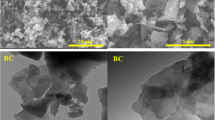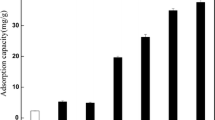Abstract
In this study, silver–ytterbium-modified biochar (MBC) was prepared to adsorb ciprofloxacin hydrochloride. It was compared with biochar (BC) and alkali-modified biochar (NBC). The results show that the MBC had more functional groups and a larger specific surface area than the BC and NBC. The saturated adsorption capacity of the MBC (312.500 mg g−1) was 3 and 19 times higher than that of the NBC and BC, respectively. The adsorption data were consistent with the pseudo-second-order kinetics model and the Langmuir isotherm model. In addition, the mechanism of CIP adsorption onto NBC and MBC may be dominated by π–π electron donor-accepter interactions. C–O, C=O and –NH2 play important roles in adsorption, and Ag–O and Yb–O groups participate in the adsorption of CIP onto MBC.


Similar content being viewed by others
References
Binh VN, Dang N, Anh NTK, Ky LX, Thai PK (2018) Antibiotics in the aquatic environment of Vietnam: sources, concentrations, risk and control strategy. Chemosphere 197:438–450
Chen HY, Jing LJ, Teng YG, Wang JS (2018) Multimedia fate modeling and risk assessment of antibiotics in a water-scarce megacity. J Hazard Mater 348:75–83
Chen SJ, Zhang BL, Xia YH, Chen H, Chen G, Tang SS (2021) Influence of mixed alkali on the preparation of edible fungus substrate porous carbon material and its application for the removal of dye. Colloids Surf A—Physicochem Eng Asp 609:125675
Cheng J, Gu J-J, Tao W, Wang P, Liu L, Wang C-Y, Li Y-K, Feng X-H, Qiu G-H, Cao F-F (2019) Edible fungus slag derived nitrogen-doped hierarchical porous carbon as a high-performance adsorbent for rapid removal of organic pollutants from water. Bioresour Technol 294:122149
Dai JW, Meng XF, Zhang YH, Huang YJ (2020) Effects of modification and magnetization of rice straw derived biochar on adsorption of tetracycline from water. Bioresour Technol 311:123455
Dou S, Ke XX, Shao ZD, Zhong LB, Zhao QB, Zheng YM (2022) Fish scale-based biochar with defined pore size and ultrahigh specific surface area for highly efficient adsorption of ciprofloxacin. Chemosphere 287:131962
Guo ZQ, Chen R, Yang RR, Yang FJ, Chen J, Li Y, Zhou R, Xu JZ (2020) Synthesis of amino-functionalized biochar/spinel ferrite magnetic composites for low-cost and efficient elimination of Ni(II) from wastewater. Sci Total Environ 722:137822
Hom-Diaz A, Norvill ZN, Blanquez P, Vicent T, Guieysse B (2017) Ciprofloxacin removal during secondary domestic wastewater treatment in high rate algal ponds. Chemosphere 180:33–41
Hu B, Tang Y, Wang X, Wu L, Nong J, Yang X, Guo J (2021) Cobalt-gadolinium modified biochar as an adsorbent for antibiotics in single and binary systems. Microchem J 166:106235
Huang H, Yi DZ, Lu YN, Wu XL, Bai YP, Meng X, Shi L (2013) Study on the adsorption behavior and mechanism of dimethyl sulfide on silver modified bentonite by in situ FTIR and temperature-programmed desorption. Chem Eng J 225:447–455
Lehmann J, Cowie A, Masiello CA, Kammann C, Woolf D, Amonette JE, Cayuela ML, Camps-Arbestain M, Whitman T (2021) Biochar in climate change mitigation. Nat Geosci 14:883–892
Li ZW, Bao N, Liu Y, Shao J, Yu H, Zhang HB, Xia L, Dong XT, Yu YJ, Feng DW (2016) Preparation and luminescence properties of TbPO4–Yb2O3/SBA-15 composites. J Lumin 180:348–354
Lian J, Qu L, Ren PF, Ren HX, Wan LZ, Guo HD, Zhang H, Chang SL, Gao X, Ban LT (2021) Industrial mushroom residue as cow bedding: analysis of microbial diversity and applications. Curr Microbiol 78(4):1448–1457
Liu WF, Zhang J, Cheng C, Tian GP, Zhang CL (2011) Ultrasonic-assisted sodium hypochlorite oxidation of activated carbons for enhanced removal of Co(II) from aqueous solutions. Chem Eng J 175:24–32
Liu RD, Li H, Duan LB, Shen H, Zhang Q, Zhao XR (2018) The synergistic effect of graphene oxide and silver vacancy in Ag3PO4-based photocatalysts for rhodamine B degradation under visible light. Appl Surf Sci 462:263–269
Mondal SK, Saha AK, Sinha A (2018) Removal of ciprofloxacin using modified advanced oxidation processes: kinetics, pathways and process optimization. J Clean Prod 171:1203–1214
Navarro-Lopez DE, Garcia-Varela R, Ceballos-Sanchez O, Sanchez-Martinez A, Sanchez-Ante G, Corona-Romero K, Buentello-Montoya DA, Elias-Zuniga A, Lopez-Mena ER (2021) Effective antimicrobial activity of ZnO and Yb-doped ZnO nanoparticles against Staphylococcus aureus and Escherichia coli. Mater Sci Eng C—Mater Biol Appl 123:112004
Pourzamani H, Mengelizadeh N, Mohammadi H, Niknam N, Neamati B, Rahimi R (2018) Comparison of electrochemical advanced oxidation processes for removal of ciprofloxacin from aqueous solutions. Desalin Water Treat 113:307–318
Qian KZ, Kumar A, Zhang HL, Bellmer D, Huhnke R (2015) Recent advances in utilization of biochar. Renew Sustain Energy Rev 42:1055–1064
Qu J, Li Y, Song T, Huang S, Wei Y, Liu X, Wang H, Jin Y (2020) Comparison of the adsorption characteristics and mechanism of Pb onto four adsorbents derived from edible fungi spent substrate. Ecol Eng 142:105639
Ruan XX, Sun YQ, Du WM, Tang YY, Liu Q, Zhang ZY, Doherty W, Frost RL, Qian GR, Tsang DCW (2019) Formation, characteristics, and applications of environmentally persistent free radicals in biochars: a review. Biores Technol 281:457–468
Shaikh WA, Islam RU, Chakraborty S (2021) Stable silver nanoparticle doped mesoporous biochar-based nanocomposite for efficient removal of toxic dyes. J Environ Chem Eng 9(1):104982
Wang F et al (2015) Adsorption of sulfamethoxazole and 17 beta-estradiol by carbon nanotubes/CoFe2O4 composites. Chem Eng J 274:17–29
Wang TF, Zhai YB, Zhu Y, Li CT, Zeng GM (2018) A review of the hydrothermal carbonization of biomass waste for hydrochar formation: process conditions, fundamentals, and physicochemical properties. Renew Sustain Energy Rev 90:223–247
Yan LL, Liu Y, Zhang YD, Liu S, Wang CX, Chen WT, Liu C, Chen ZL, Zhang Y (2020) ZnCl2 modified biochar derived from aerobic granular sludge for developed microporosity and enhanced adsorption to tetracycline. Bioresour Technol 297:122381
Yu JX, Tong M, Sun XM, Li BH (2007) Poly (methacrylic acid) modified biomasss for enhancement adsorption of Pb2+, Cd2+ and Cu2+. J Chem Technol Biotechnol 82(6):558–565
Zhu L, Tong LH, Zhao N, Wang X, Yang XX, Lv YZ (2020) Key factors and microscopic mechanisms controlling adsorption of cadmium by surface oxidized and aminated biochars. J Hazardous Mater 382:121002
Acknowledgements
This research was funded by Natural Science Foundation of Guangxi province: 2017GXNSFBA198168.
Author information
Authors and Affiliations
Corresponding author
Ethics declarations
Conflict of interest
There are no conflict of interest to declare.
Additional information
Publisher's Note
Springer Nature remains neutral with regard to jurisdictional claims in published maps and institutional affiliations.
Supplementary Information
Below is the link to the electronic supplementary material.
Rights and permissions
About this article
Cite this article
Tang, Y., Hao, J., He, S. et al. Characterization of Edible Fungus Substrate Modified Biochar and Its Adsorption Capacity for Ciprofloxacin Hydrochloride. Bull Environ Contam Toxicol 108, 1153–1158 (2022). https://doi.org/10.1007/s00128-022-03463-0
Received:
Accepted:
Published:
Issue Date:
DOI: https://doi.org/10.1007/s00128-022-03463-0




